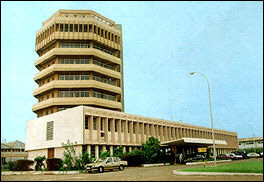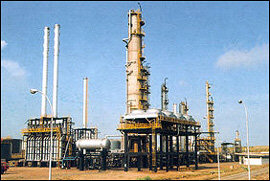
|

 COMPANY PROFILE COMPANY PROFILE
The Tema Oil Refinery was conceived in 1960 as part of the Ghana Governments Industrialisation programme. Thus the Government of Ghana in conjunction with the Entre National Idrocarburi, formed the Ghana Italian Company (GHAIP) with the object of carrying on refining in the country.

In December 1961, GHAIP entrusted a consortium of firms, consisting of SNAM project SAIPEM and NUOVO PIGNONE, with the construction of a refinery at Team cable of processing the most varied forms of crude. The capacity was 1,250,000 tons of crude oil per year. By the middle of 1963, the refinery had been completed and it covered a total area of 440,000 square metres.
 THE PROCESS THE PROCESS
The Tema Oil Refinery is linked to an oil jetty at the Tema Harbour by a 24 inches diameter crude oil pipeline. There are other products lines of 14, 10 and 6 inches diameter for export and import of finished products.
When ships arrived at the harbour, inspections are done for quality and quantity.
Then the Fuel is pumped through pipelines into the floating roof storage tanks. As there is a sizeable amount of water in the crude, it is allowed to settle for two days before it is ready for processing.
 REFINING REFINING
The crude is pumped from the storage tanks to the TOPPING UNIT where it is gradually heated in a train of heat exchangers from ambient temperature to 330 350 degrees centigrade. It is then distilled at approximately atmospheric pressure into various fractions:
LPG 2%
VIRGIN NAPTHTA 25%
S.R. KORESENE 14%
GAS OIL 33%
REDUCED CRUDE 26%
The Naphtha from the Topping Unit is further treated in the Reforming Unit where the Octane level is raised to meet the market specification. Refined products from the processing units are stored into various storage tanks where the products are prepared to meet market specification.

|
 FINISHED PRODUCTS FINISHED PRODUCTS
LIQUIFIED PETROLEUM GAS (LPG)
This is commonly called GAS and is made Up of 20% propane and 80% by volume of butane gas. It is used as domestic, commercial and industrial fuel.
MOTOR GASOLINE
These meet the need of cars. Premium Gasoline (Super) caters for engines with high revolutions per minute.
KEROSENE
This is a refined petroleum distillate suitable for use as an Illuminant when burned in a wick lamp.
AVIATION TURBINE KEROSENE
This is a grade of kerosene of such composition and characteristics that is suitable for use as aviation turbine fuel.
GAS OIL (Diesel Oil)
A petroleum distillate with a viscosity range between that of kerosene and residual fuel oil. It is suitable as fuel in high-speed DIESEL ENGINES.
INDUSTRIAL DIESEL OIL
A blend of Gas oil and Residual Fuel oil (about) 70% by weight of Gas oil, about 30% by weight of fuel oil.
INLAND FUEL OIL
This is burned Fuel oil of lower viscosity than Residual Fuel Oil, generally obtained by blending Residual Fuel oil with petroleum 1 middle distillates.
INLAND FUEL OIL (Bunker C)
This is a high viscosity oil obtained as a residue from the distillation of crude oil.
It is needed mostly for industrial heating, Furnace Boilers, etc and pre-heating to Permit pumping and additional pre-heating to permit atonizing.
 WHAT IS NEW WHAT IS NEW
The crude distillation Unit (CDU) has been revamped from 28000 to 45000 barrels per stream day (BPSD).
With the objective of making the most out of the barrel of Crude, TOR has entered into agreement for Secondary Conversion Processes. In the light of this plans are far advanced for the building of an RFCC (Residue Fluid Catalytic Cracking) Unit to convert the Residual Fuel Oil from the CDU into more valuable products Gasoil, Gasoline and LPG.
The Reforming Unit is also being studied with the view to increasing its capacity to be able to handle the increased Naphtha production from the Revamped CDU.
ADDRESS
P.O. Box Co 599
Tema, Ghana
Tel. : 233 22 304095/7
233 22 302881/3
Fax. : 233 22 302910
233 22 302884
Email : tor@tor.com.gh
|
© World INvestment NEws, 1999.
This is the electronic edition of the special country report on Ghana published in Forbes
December 13th 1999 Issue.
Developed by AgenciaE.Tv |
|
|
|
|
|
|
|
|
|
|
|

